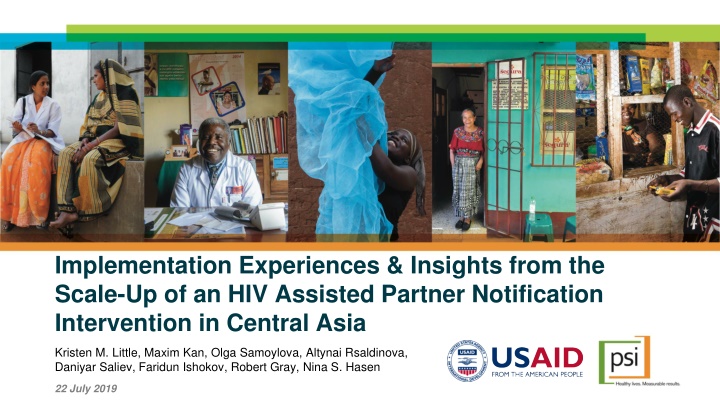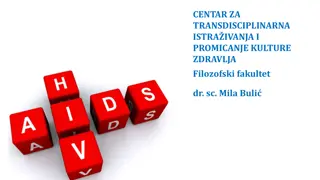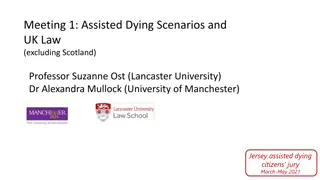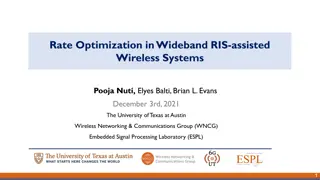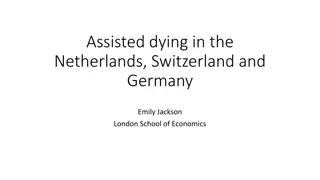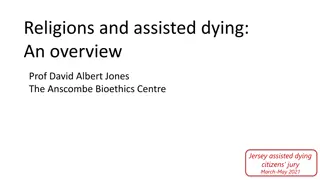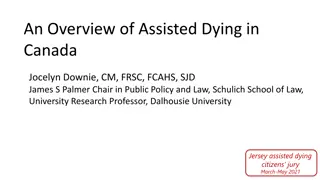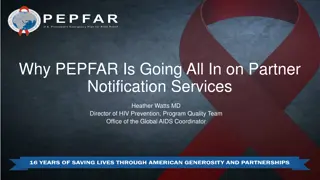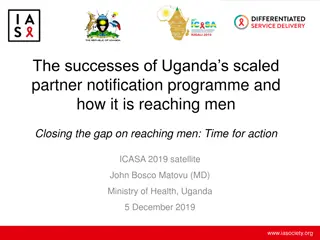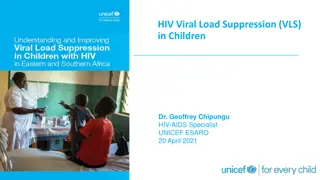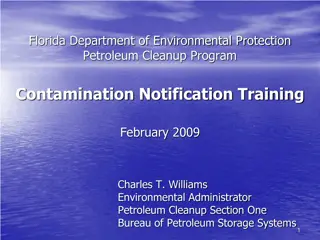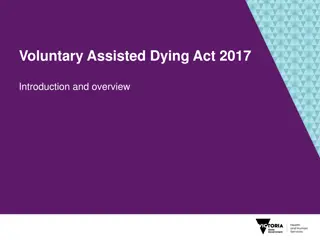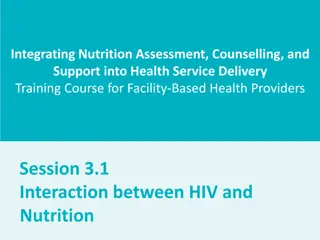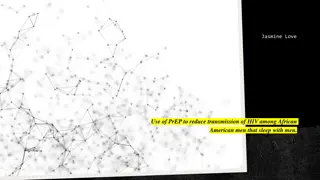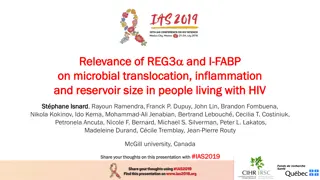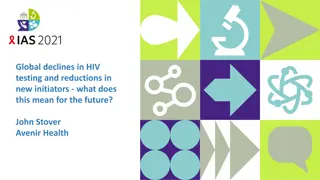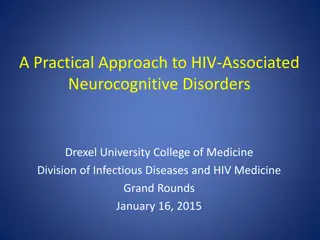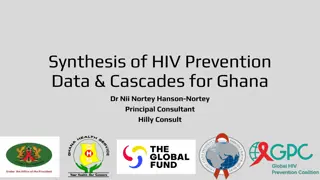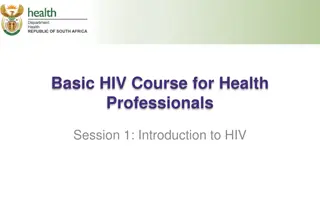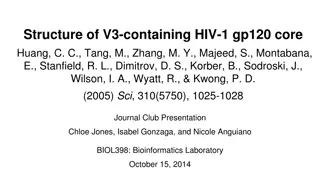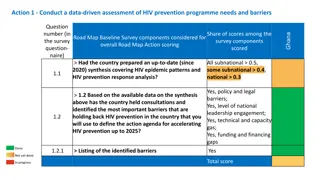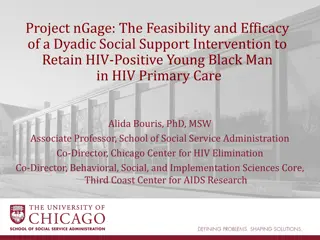Insights from Scale-Up of HIV Assisted Partner Notification Intervention
The study discusses the implementation of an Assisted Partner Notification (APN) intervention for HIV in Central Asia, particularly focusing on people who inject drugs (PWID). With support from USAID, the project aimed to address the concentrated HIV epidemic in the region. The research outlines the background of HIV prevalence among PWID in countries like Tajikistan, Kyrgyz Republic, and Kazakhstan, highlighting obstacles to epidemic control. The program overview details the implementation phases, including the pre-APN and APN periods. By analyzing routine program data, the study aims to compare outcomes between these periods and understand the impact of the APN intervention.
Download Presentation

Please find below an Image/Link to download the presentation.
The content on the website is provided AS IS for your information and personal use only. It may not be sold, licensed, or shared on other websites without obtaining consent from the author.If you encounter any issues during the download, it is possible that the publisher has removed the file from their server.
You are allowed to download the files provided on this website for personal or commercial use, subject to the condition that they are used lawfully. All files are the property of their respective owners.
The content on the website is provided AS IS for your information and personal use only. It may not be sold, licensed, or shared on other websites without obtaining consent from the author.
E N D
Presentation Transcript
Implementation Experiences & Insights from the Scale-Up of an HIV Assisted Partner Notification Intervention in Central Asia Kristen M. Little, Maxim Kan, Olga Samoylova, Altynai Rsaldinova, Daniyar Saliev, Faridun Ishokov, Robert Gray, Nina S. Hasen 22 July 2019
Conflicts of Interest I have no conflicts of interest to declare This work was supported by the USAID Central Asia HIV Flagship Activity Project (Contract Number: AID-176-C-16-0001) page 2
Background The HIV epidemics in Central Asia are highly concentrated Disproportionately impact people who inject drugs (PWID) Sexual partners of PWID An estimated 168,600 PWID in Kazakhstan, the Kyrgyz Republic, and Tajikistan page 3
Background 13.5% Tajikistan HIV Prevalence among PWID HIV prevalence estimates among PWID range from 9.3%-13.5% Compared to 0.13%-0.19% among the general population 12.4% Kyrgyz Republic Obstacles to HIV epidemic control Laws and policies that discriminate against key populations Stigma and marginalization that limit access to HIV services Minimal epidemiological data to inform program design and targeting 9.3% Kazakhstan page 4
Background WHO recommends assisted partner notification (APN) services for people living with HIV (PLHIV) These services have not been widely scaled in Central Asia We describe the results from an APN intervention implemented within a program focused on PLHIV and PWID in Kazakhstan, the Kyrgyz Republic, and Tajikistan USAID-funded Flagship Project page 5
Program Overview Pre-APN Period: Consenting index cases recruited sexual and injecting partners using passive referral Coupon-based referral APN Period: Had choice of passive (coupon-based) referral or APN APN included provider, contract, or dual-referral options page 6
Methods To better understand differences in outcomes between the pre-APN and APN periods, we: Analyzed de-identified routine program data before/after APN launch Index cases and their sexual and injecting partners Equal-length periods before and after APN intervention scaled One month wash-out period during APN scale-up Compared the demographic characteristics of index cases and sexual/injecting partners from pre-APN and APN periods, Number/proportion of HIV cases found (positivity rate) Comparison of index case characteristics before/after APN Comparison of partner characteristics before/after APN Estimated partners recruited per index case & the number of index cases needed to find one new partner with HIV page 7
The number of index cases decreased under APN, while number of partners increased Index Cases and Partners Recruited by Country & Pre-APN vs. APN Period Number of index cases recruited fell from 4,418 to 2,675 under APN Partners recruited increased 1.7 times, from 2,245 to 3,735 4,500 Index Cases Partners 4,000 3,500 3,000 2,500 2,000 1,500 1,000 405 500 1,491 1,333 1,090 1,068 1,416 1,667 1,511 1,000 4,418 2,245 2,675 3,735 956 507 629 0 Pre-APN APN Pre-APN APN Pre-APN APN Pre-APN APN Kazakhstan Kyrgyz Republic Tajikistan Total page 9
Index Case Characteristics Before/After APN Kazakhstan (N=2,581) Kyrgyz Republic (N=2,372) Tajikistan (N=2,140) Pre-APN (n=1,491) N (%) 568 (38.1) APN (n=1,090) N (%) 406 (37.3) Pre-APN (n=1,416) N (%) 622 (43.9) APN (n=956) N (%) 367 (38.4) Pre-APN (n=1,511) N (%) 660 (43.7) APN (n=629) N (%) 233 (37.0) Variable P-value P-value P-value Female 0.661 0.007 0.005 Age (Median, IQR) 38 (33-43) 37 (32-43) 0.002 39 (33-45) 39 (32.5-45) 0.764 39 (32-45) 36 (30-44) <0.001 Project Entry Newly found Lost to follow-up 70 (4.7) 292 (19.6) 108 (9.9) 136 (12.5) 157 (11.2) 253 (18.0) 224 (23.4) 118 (12.3) 168 (11.1) 304 (20.1) 1,039 (68.8) 228 (36.3) 107 (17.0) <0.001 <0.001 <0.001 Pre-ART Care 1,129 (75.7) 846 (77.6) 997 (70.9) 614 (64.2) 294 (46.7) Has not disclosed status to anyone ART Status Never on ART Newly started Reinitiated Already on ART Previously on ART 229 (16.2) 260 (24.0) <0.001 528 (37.9) 540 (56.7) <0.001 354 (23.4) 189 (30.1) 0.001 621 (41.7) 368 (24.7) 415 (27.8) 2 (0.1) 85 (5.7) 327 (30.0) 513 (47.1) 156 (14.3) 0 (0.0) 94 (8.6) 370 (26.1) 387 (27.3) 534 (37.7) 22 (1.6) 103 (7.3) 348 (36.4) 364 (38.1) 210 (22.0) 0 (0.0) 34 (3.6) 142 (9.4) 332 (22.0) 843 (55.8) 0 (0.0) 194 (12.8) 151 (24.0) 288 (45.8) 123 (19.6) 0 (0.0) 67 (10.7) <0.001 <0.001 <0.001 page 10
Index Case Characteristics Before/After APN Kazakhstan (N=2,581) Kyrgyz Republic (N=2,372) Tajikistan (N=2,140) Pre-APN (n=1,491) N (%) 568 (38.1) APN (n=1,090) N (%) 406 (37.3) Pre-APN (n=1,416) N (%) 622 (43.9) APN (n=956) N (%) 367 (38.4) Pre-APN (n=1,511) N (%) 660 (43.7) APN (n=629) N (%) 233 (37.0) Variable P-value P-value P-value Female 0.661 0.007 0.005 Age (Median, IQR) 38 (33-43) 37 (32-43) 0.002 39 (33-45) 39 (32.5-45) 0.764 39 (32-45) 36 (30-44) <0.001 Project Entry Newly found Lost to follow-up 70 (4.7) 292 (19.6) 108 (9.9) 136 (12.5) 157 (11.2) 253 (18.0) 224 (23.4) 118 (12.3) 168 (11.1) 304 (20.1) 1,039 (68.8) 228 (36.3) 107 (17.0) <0.001 <0.001 <0.001 Pre-ART Care 1,129 (75.7) 846 (77.6) 997 (70.9) 614 (64.2) 294 (46.7) Has not disclosed status to anyone ART Status Never on ART Newly started Reinitiated Already on ART Previously on ART 229 (16.2) 260 (24.0) <0.001 528 (37.9) 540 (56.7) <0.001 354 (23.4) 189 (30.1) 0.001 621 (41.7) 368 (24.7) 415 (27.8) 2 (0.1) 85 (5.7) 327 (30.0) 513 (47.1) 156 (14.3) 0 (0.0) 94 (8.6) 370 (26.1) 387 (27.3) 534 (37.7) 22 (1.6) 103 (7.3) 348 (36.4) 364 (38.1) 210 (22.0) 0 (0.0) 34 (3.6) 142 (9.4) 332 (22.0) 843 (55.8) 0 (0.0) 194 (12.8) 151 (24.0) 288 (45.8) 123 (19.6) 0 (0.0) 67 (10.7) <0.001 <0.001 <0.001 page 11
Index Case Characteristics Before/After APN Kazakhstan (N=2,581) Kyrgyz Republic (N=2,372) Tajikistan (N=2,140) Pre-APN (n=1,491) N (%) 568 (38.1) APN (n=1,090) N (%) 406 (37.3) Pre-APN (n=1,416) N (%) 622 (43.9) APN (n=956) N (%) 367 (38.4) Pre-APN (n=1,511) N (%) 660 (43.7) APN (n=629) N (%) 233 (37.0) Variable P-value P-value P-value Female 0.661 0.007 0.005 Age (Median, IQR) 38 (33-43) 37 (32-43) 0.002 39 (33-45) 39 (32.5-45) 0.764 39 (32-45) 36 (30-44) <0.001 Project Entry Newly found Lost to follow-up 70 (4.7) 292 (19.6) 108 (9.9) 136 (12.5) 157 (11.2) 253 (18.0) 224 (23.4) 118 (12.3) 168 (11.1) 304 (20.1) 1,039 (68.8) 228 (36.3) 107 (17.0) <0.001 <0.001 <0.001 Pre-ART Care 1,129 (75.7) 846 (77.6) 997 (70.9) 614 (64.2) 294 (46.7) Has not disclosed status to anyone ART Status Never on ART Newly started Reinitiated Already on ART Previously on ART 229 (16.2) 260 (24.0) <0.001 528 (37.9) 540 (56.7) <0.001 354 (23.4) 189 (30.1) 0.001 621 (41.7) 368 (24.7) 415 (27.8) 2 (0.1) 85 (5.7) 327 (30.0) 513 (47.1) 156 (14.3) 0 (0.0) 94 (8.6) 370 (26.1) 387 (27.3) 534 (37.7) 22 (1.6) 103 (7.3) 348 (36.4) 364 (38.1) 210 (22.0) 0 (0.0) 34 (3.6) 142 (9.4) 332 (22.0) 843 (55.8) 0 (0.0) 194 (12.8) 151 (24.0) 288 (45.8) 123 (19.6) 0 (0.0) 67 (10.7) <0.001 <0.001 <0.001 page 12
Positivity rate increased slightly under APN HIV Status of Partners Recruited by Country and Period 4,000 16% 15.2% 14.0% 322 3,500 14% HIV- Partners HIV+ Partners Positivity Rate 3,000 12% 8.6% 2,500 10% 7.9% 161 6.3% 2,000 8% 7.2% 58 4.4% 105 6.1% 1,500 6% 1,000 4% 65 152 71 32 500 2% 1,275 1,003 373 1,562 436 848 2,084 3,413 0 0% Pre-APN APN Pre-APN APN Pre-APN APN Pre-APN APN Kazakhstan Kyrgyz Republic Tajikistan Total
Partner Characteristics Before/After APN Kazakhstan (N=2,401) Pre-APN (N=1,333 55.5%) N (%) 618 (46.4) 37 (31-43) Kyrgyz Republic (N=2,072) Pre-APN (N=405, 19.6%) N (%) 258 (63.7) 38 (31-45) Tajikistan (N=1,507) Pre-APN (N=507, 33.6%) N (%) 253 (49.9) 37 (30-44) APN APN APN P- (N=1,068, 44.5%) N (%) 478 (44.8) 36 (30-42) (N=1,667, 80.5%) N (%) 859 (51.5) 36 (30-43) (N=1,000, 66.4%) N (%) 623 (62.3) 34 (28-40) Variable P-value P-value value Female Age (Median, IQR Tested for HIV previously* Shared needles with recruiter** Had sex with recruiter*** Migration experience Positive HIV test 0.433 0.018 <0.001 0.010 <0.001 <0.001 -- -- -- 128 (31.8) 85 (16.1) <0.001 76 (15.0) 108 (10.8) 0.019 2 (0.2) 3 (0.3) 0.465 20 (5.1) 13 (2.5) 0.035 6 (2.8) 63 (26.8) <0.001 1,311 (99.9) 1,066 (99.8) 0.448 400 (99.0) 524 (99.2) 0.703 216 (100) 201 (85.5) <0.001 -- -- -- -- -- -- 224 (44.2) 329 (32.9) <0.001 58 (4.4) 65 (6.1) 0.058 32 (7.9) 105 (6.3) 0.247 71 (14.0) 152 (15.2) 0.537 page 14
Partner Characteristics Before/After APN Kazakhstan (N=2,401) Pre-APN (N=1,333 55.5%) N (%) 618 (46.4) 37 (31-43) Kyrgyz Republic (N=2,072) Pre-APN (N=405, 19.6%) N (%) 258 (63.7) 38 (31-45) Tajikistan (N=1,507) Pre-APN (N=507, 33.6%) N (%) 253 (49.9) 37 (30-44) APN APN APN P- (N=1,068, 44.5%) N (%) 478 (44.8) 36 (30-42) (N=1,667, 80.5%) N (%) 859 (51.5) 36 (30-43) (N=1,000, 66.4%) N (%) 623 (62.3) 34 (28-40) Variable P-value P-value value Female Age (Median, IQR Tested for HIV previously* Shared needles with recruiter** Had sex with recruiter*** Migration experience Positive HIV test 0.433 0.018 <0.001 0.010 <0.001 <0.001 -- -- -- 128 (31.8) 85 (16.1) <0.001 76 (15.0) 108 (10.8) 0.019 2 (0.2) 3 (0.3) 0.465 20 (5.1) 13 (2.5) 0.035 6 (2.8) 63 (26.8) <0.001 1,311 (99.9) 1,066 (99.8) 0.448 400 (99.0) 524 (99.2) 0.703 216 (100) 201 (85.5) <0.001 -- -- -- -- -- -- 224 (44.2) 329 (32.9) <0.001 58 (4.4) 65 (6.1) 0.058 32 (7.9) 105 (6.3) 0.247 71 (14.0) 152 (15.2) 0.537 page 15
Number of partners recruited per index case increased under APN Increased from 0.5 partners per index in the pre- APN period to 1.4 under APN Increase largest in KG (0.3 to 1.7) and TJ (0.3- 1.6) Partners Tested per Index Case 2 Pre-APN APN 1.8 1.6 1.4 Index Cases (#) 1.2 1 0.8 0.6 0.4 0.2 0.89 0.98 0.29 1.74 0.34 1.59 0.51 1.40 0 KZ KG TJ Total page 16
The number of index cases needed to find one positive partner decreased under APN The number of index cases needed to find one new HIV+ partner fell from 27.4 during pre-APN to 8.3 under APN Decreases seen across countries Largest drops in KG (80%) and TJ (81%) Number of Index Cases Needed to Identify One Positive Partner 50 45 Pre-APN APN 40 35 Index Cases (#) 30 25 20 15 10 4.14 5 25.71 16.77 44.25 9.10 21.28 27.44 8.31 0 KZ KG TJ Total page 17
Limitations Analysis based on routine monitoring data Monitoring system not designed to link index cases to partners Unable to assess whether differences among index cases accounted for improved outcomes Unable to assess factors behind country-level heterogeneity Did not collect information on the proportion of PLHIV agreeing to serve as index cases No information on the proportion of index cases who recruited a partner Risk behaviors based on self-report Limited demographic and behavioral data collected High missingness for some variables page 19
Conclusions APN services feasible in Central Asia Able to be implemented alongside other HIV case-finding/management services In context of PWID-focused HIV case-finding and management program Though positivity rates varied across countries, APN resulted in: Increases in the number of new HIV cases diagnosed among partners Significant increases in number of partners recruited per index case Significant reductions in number of index cases needed to find a new HIV-positive partner Focusing additional resources on APN, using good practice tools and methods, may be feasible approach to improve HIV case-finding among hard-to-reach populations Scale-up of APN services needed in Central Asia More operational and implementation science research needed to optimize efficiency and effectiveness of APN in this setting page 20
Visit the journal website to access the special issue www.jiasociety.org
Acknowledgements Co-authors Flagship and PSI staff NGO implementing partners Peer Navigators and clients in Central Asia USAID page 22
Questions? Comments?
